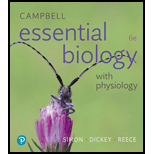
Concept explainers
Which of the following statements is a correct distinction between autotrophs and heterotrophs?
- a. Only heterotrophs require chemical compounds from the environment.
- b.
Cellular respiration is unique to heterotrophs. - c. Only heterotrophs have mitochondria.
- d. Only autotrophs can live or nutrients that are entirely inorganic.
Introduction:
Photosynthesis is the process of conversion of light energy into chemical energy and organic molecules. This process is performed in chloroplasts of algae and plants. All animals for food depend on this conversion.
Answer to Problem 1SQ
Correct answer:
The distinction between autotrophs and heterotrophs is that only autotrophs can live on nutrients that are entirely inorganic. Therefore, option d. is correct.
Explanation of Solution
Reason for the correct statement:
Autotrophs are the organisms that synthesis their own food such as lipids, nucleic acids, proteins and carbohydrates from inorganic matter like carbon dioxide, water and minerals.
Option d. is given as “only autotrophs can live on nutrients that are entirely inorganic”.
As, “the distinction between autotrophs and heterotrophs is that only autotrophs can live on nutrients that are entirely inorganic” it is the right answer.
Hence, option d. is the correct answer.
Reasons for the incorrect statements:
Option a. is given as “Only heterotrophs require chemical compounds from the environment”.
Heterotrophs are also known as consumers that depend on the organic matter produced by the autotrophs because they cannot utilize the inorganic material present in the surroundings. So, it is the wrong answer.
Option b. is given as “Cellular respiration is unique to heterotrophs”.
Cellular respiration is the chemical process in which the stored energy in the chemical bonds is converted into ATP by action of O2. This process occurs in the cells of heterotrophs as well as autotrophs. So, it is the wrong answer.
Option c. is given as “Only heterotrophs have mitochondria”.
Mitochondria are known as “power house of the cell” and it is present in autotrophs and heterotrophs which help in production of ATP through respiration. So, it is the wrong answer.
Hence, options a., b. and c. are incorrect.
The autotrophs are known as producers because they can synthesis their own food by converting inorganic matter like carbon dioxide, water and minerals into chemical energy in the form of sugar organic compound).
Want to see more full solutions like this?
Chapter 6 Solutions
Campbell Essential Biology with Physiology (6th Edition)
Additional Science Textbook Solutions
Laboratory Manual For Human Anatomy & Physiology
Campbell Essential Biology (7th Edition)
HUMAN ANATOMY
Genetics: From Genes to Genomes
Biology: Life on Earth with Physiology (11th Edition)
- Explain how the hormones of the glands listed below travel around the body to target organs and tissues : Pituitary gland Hypothalamus Thyroid Parathyroid Adrenal Pineal Pancreas(islets of langerhans) Gonads (testes and ovaries) Placentaarrow_forwardWhat are the functions of the hormones produced in the glands listed below: Pituitary gland Hypothalamus Thyroid Parathyroid Adrenal Pineal Pancreas(islets of langerhans) Gonads (testes and ovaries) Placentaarrow_forwardDescribe the hormones produced in the glands listed below: Pituitary gland Hypothalamus Thyroid Parathyroid Adrenal Pineal Pancreas(islets of langerhans) Gonads (testes and ovaries) Placentaarrow_forward
- Please help me calculate drug dosage from the following information: Patient weight: 35 pounds, so 15.9 kilograms (got this by dividing 35 pounds by 2.2 kilograms) Drug dose: 0.05mg/kg Drug concentration: 2mg/mLarrow_forwardA 25-year-old woman presents to the emergency department with a 2-day history of fever, chills, severe headache, and confusion. She recently returned from a trip to sub-Saharan Africa, where she did not take malaria prophylaxis. On examination, she is febrile (39.8°C/103.6°F) and hypotensive. Laboratory studies reveal hemoglobin of 8.0 g/dL, platelet count of 50,000/μL, and evidence of hemoglobinuria. A peripheral blood smear shows ring forms and banana-shaped gametocytes. Which of the following Plasmodium species is most likely responsible for her severe symptoms? A. Plasmodium vivax B. Plasmodium ovale C. Plasmodium malariae D. Plasmodium falciparumarrow_forwardStandard Concentration (caffeine) mg/L Absorbance Reading 10 0.322 20 0.697 40 1.535 60 2.520 80 3.100arrow_forward
- please draw in the answers, thank youarrow_forwarda. On this first grid, assume that the DNA and RNA templates are read left to right. DNA DNA mRNA codon tRNA anticodon polypeptide _strand strand C с A T G A U G C A TRP b. Now do this AGAIN assuming that the DNA and RNA templates are read right to left. DNA DNA strand strand C mRNA codon tRNA anticodon polypeptide 0 A T G A U G с A TRParrow_forwardplease answer all question below with the following answer choice, thank you!arrow_forward
 Concepts of BiologyBiologyISBN:9781938168116Author:Samantha Fowler, Rebecca Roush, James WisePublisher:OpenStax College
Concepts of BiologyBiologyISBN:9781938168116Author:Samantha Fowler, Rebecca Roush, James WisePublisher:OpenStax College Biology (MindTap Course List)BiologyISBN:9781337392938Author:Eldra Solomon, Charles Martin, Diana W. Martin, Linda R. BergPublisher:Cengage Learning
Biology (MindTap Course List)BiologyISBN:9781337392938Author:Eldra Solomon, Charles Martin, Diana W. Martin, Linda R. BergPublisher:Cengage Learning Biology Today and Tomorrow without Physiology (Mi...BiologyISBN:9781305117396Author:Cecie Starr, Christine Evers, Lisa StarrPublisher:Cengage Learning
Biology Today and Tomorrow without Physiology (Mi...BiologyISBN:9781305117396Author:Cecie Starr, Christine Evers, Lisa StarrPublisher:Cengage Learning
 BiochemistryBiochemistryISBN:9781305577206Author:Reginald H. Garrett, Charles M. GrishamPublisher:Cengage Learning
BiochemistryBiochemistryISBN:9781305577206Author:Reginald H. Garrett, Charles M. GrishamPublisher:Cengage Learning





